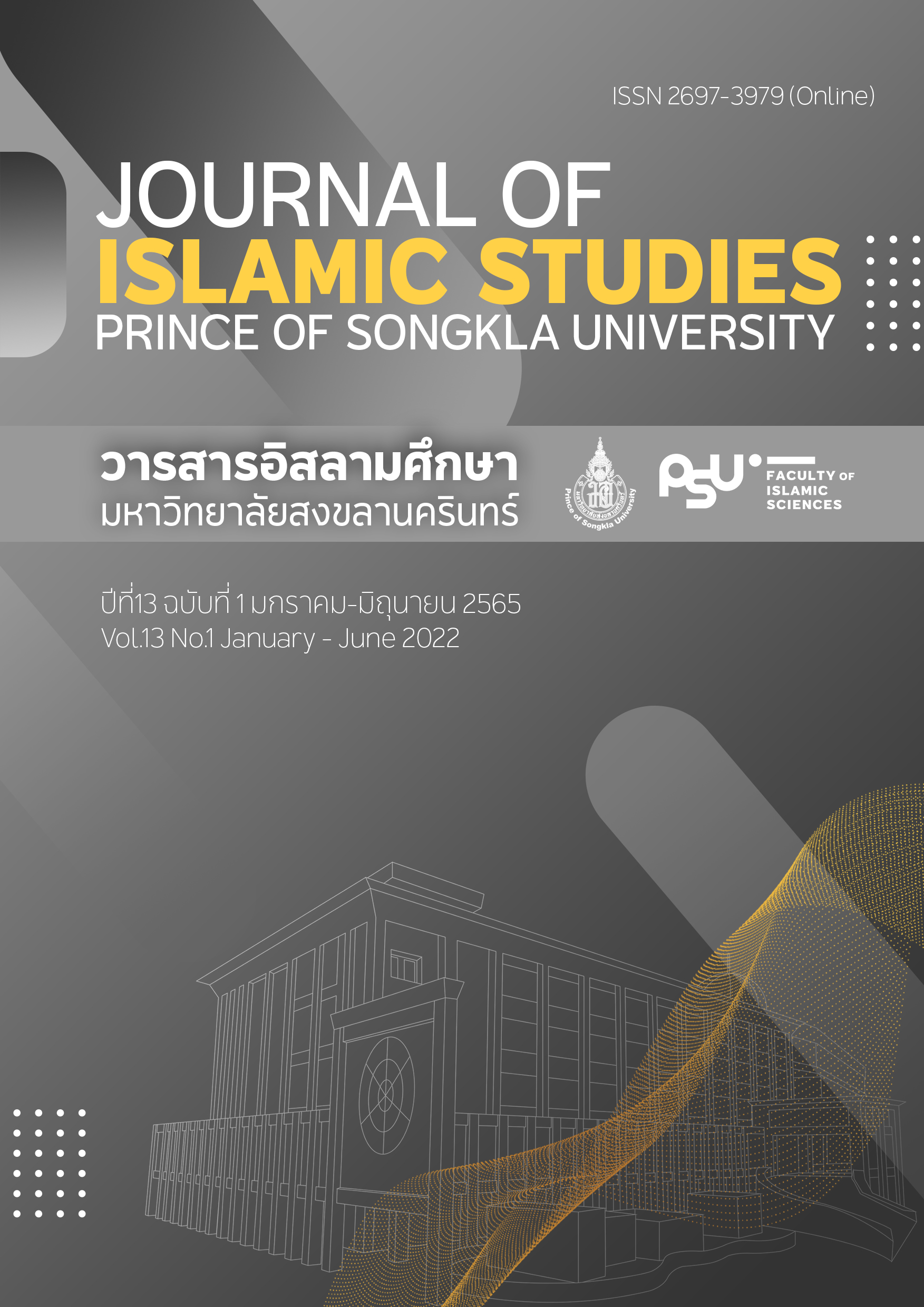ความสัมพันธ์ระหว่างประเทศกับมุมมองอิสลาม
คำสำคัญ:
ความสัมพันธ์ระหว่างประเทศ, ทัศนะอิสลาม, สงครามและสันติภาพบทคัดย่อ
จุดประสงค์ 1) เพื่อนำเสนอความสัมพันธ์ระหว่างประเทศในทัศนะอิสลามผ่านการตีความของนักนิติศาสตร์อิสลาม และ 2) เพื่อสร้างความรู้และคำอธิบายเกี่ยวกับการอยู่ร่วมกันระหว่างมุสลิมและชนที่ไม่ใช่มุสลิมบริบทที่มีความหลากหลายของกลุ่มชนต่างๆ อันเป็นที่มาของชุมชนและรัฐ
วิธีการศึกษา การศึกษาเชิงคุณภาพโดยอาศัยแหล่งข้อมูลทุตยภูมิที่เป็นการรวบรวมและวิเคราะห์การตีความประเด็นความสัมพันธ์ระหว่างประเทศของนักนิติศาสตร์อิสลามในห้วงประวัติศาสตร์อิสลามและโลกร่วมสมัย
ผลการศึกษา พบว่าความสัมพันธ์ระหว่างประเทศในความเข้าใจของนักนิติศาสตร์อิสลาม คือความสัมพันธ์ระหว่างมนุษย์ที่ครอบคลุมทั้งมุสลิมและผู้ที่มิใช่มุสลิม ซึ่งในประวัติศาสตร์อิสลามนั้นนครมะดีนะฮ์ถือเป็นรัฐต้นแบบของการจัดการความสัมพันธ์ระหว่างรัฐผ่านการจัดทำสนธิสัญญาและสงคราม นักนิติศาสตร์อิสลามได้จำแนกรูปแบบความสัมพันธ์ออกเป็น 3 ลักษณะคือ ดินแดนแห่งสันติ (ดารุลอิสลาม) ดินแดนแห่งสงคราม (ดารุลฮัรบ์) และดินแดนแห่งสนธิสัญญา (ดารุลซุลฮ์) และเมื่อพิจารณาประเด็นปัญหาในการเมืองโลกร่วมสมัยที่อิสลามและมุสลิมเป็นตัวแสดงในระบบความสัมพันธ์ระหว่างประเทศซึ่งถูกผูกโยงกับการก่อการร้ายหรือเป็นภัยคุกคามต่อสันติภาพของโลก การนำแนวคิดจิฮาดในมิติของการตีความและการปฏิบัติจึงมีความจำเป็น
การนำผลการศึกษาไปใช้ เป็นแหล่งข้อมูลอ้างอิงทางวิชาการและการเรียนการสอนในสาขาวิชาด้านรัฐศาสตร์และความสัมพันธ์ระหว่างประเทศ ซึ่งมีองค์ความรู้ที่ได้รับอิทธิพลหลักมาจากการศึกษาปฏิสัมพันธ์ระหว่างรัฐและสังคมยุโรป แต่ยังมีข้อจำกัดในการวิเคราะห์และตีความในบริบทที่เชื่อมโยงกับประวัติศาสตร์อิสลามและการเมืองโลกมุสลิมร่วมสมัย
เอกสารอ้างอิง
Abdou Selim, A. (2015). The Concept of Coexistence in Islamic Primary Sources: An Analytical Examination. Cambridge Scholars Publishing.
Abo-Kazleh, M. (2006). Rethinking International Relations Theory in Islam: Toward a More Adequate Approach. Alternatives: Turkish Journal of International Relations, 5(4), 41-56.
Abu Zahra, M. (2006). kotkēn ʻItsalām nai kāntham songkhrām. [The Islamic Rules of War]. 2nd ed. Saisamphan.
AbuSulayman, A. (1993). Towards an Islamic Theory of International Relations: New Directions for Methodology and Thought, (2nd ed.). The International Institute of Islamic Thought.
Al-Shanqette, M. A. (2009). ʻItsalām sātsanā thī sombūn. [Islam: The Perfectly Complete Religion]. 2nd ed. Natcha Printing.
Al-Zuhili, W. (2005). Islam and International Law. International Review of the Red Cross. 87(858), 269-283. Retrieved from https://internationalreview.icrc.org/sites/default/files/irrc_858-3.pdf
An-Naim, A. (1987). Islamic Law, International Relations, and Human Rights: Challenge and Response. Cornell International Law Journal, 20(2). 317-335.
Chai-aksornvej, A. (2006). ʻumma nai thāna Cosmopolitanism : khwāmpen nư̄a dīaokan rư̄ khwām lāilāk. [Ummah as Cosmopolitanism: Homogeneity or Heterogeneity. An article presented in the National Graduate Research Conference on Transnationalism, Faculty of Political Science, Thammasat University. 30 November 2006.
As-Sibaa'ie, M. (2010). thammai lōk čhưng tō̜ng lư̄ak ʻItsalām. [Civilization of Faith: A Journey though Islamic History]. Translated by Ahman Sona. Thammasat University Press.
Baroudi, S. E. (2018). Sheikh Muhammad Abu Zahra (1898–1974) on International Relations: The Discourse of a Contemporary Mainstream Islamist. Middle Eastern Studies, 54(3), 415-441.
Bsoul, L. A. (2007). Theory of International Relations in Islam. Digest of Middle East Studies. 16 (2), 71-91. Retrieved from https://onlinelibrary.wiley.com/doi/pdf/10.1111/j.1949-3606.2007.tb00127.x
Fuller, G. (2008). The World without Islam. Foreign Policy 164, (46-53).
Hassan, M. (2007). War, Peace or Neutrality: An Overview of Islamic Polity’s Basis of Inter-State Relations, Working Paper No. 130 S. Rajaratnam School of International Studies Singapore. Retrieved from www.rsis.edu.sg/wp-content/uploads/rsis-pubs/WP130.pdf
International Union of Muslim Scholars. (n.d.). A Fatwa concerning the term “dar al silm wa al-Islam” as Inclusive of Dagestan and Similar Countries. Retrieved from http://iumsonline.org/portal/en-US/conferences-seminars/34/c/a-fatwa-on-%E2%80%9Cdar-al-islam%E2%80%9D-as-inclusive-of-dagestan/5836/
Ali, I. (2009). Usul al-Fiqh. 2nd ed. Mittrabharp.
Chapakiya, I. L. (2015). Weekly Islamic Quranic Commentary: Tafsir Surah Al-Furqan. Majils Ilmi Bra-o, Pattani. 13 July 2015.
Khadduri, M. (1955). War and Peace in the Law of Islam. The Johns Hopkins Press.
Lerman, E. (1981). Mawdudi’s Concept of Islam. Middle East Studies, 17 (4). 492-509. Retrieved from http://www.jstor.org/stable/4282856
Mandaville, P. G. (2001). Transnational Muslim politics: Reimagining the umma. Routledge.
Moten, A. R. (1996). Political Science: An Islamic Perspective. Macmillan Press Ltd.
Piscatori, J. (n.d.). International Relations and Diplomacy. In The Oxford Encyclopedia of the Islamic World. Oxford Islamic Studies Online 1. Retrieved from http://www.oxfordislamicstudies.com/article/opr/t236/e0375
Qutb, S. (1981). lakchai ʻItsalām. [Milestones]. Translated by Bharadon. Thai Muslim Students Association.
Qutb, S. (1984). ʻItsalām læ santiphāp sākon. [Islam and Universal Peace]. Translated by Bharadon. Thai Muslim Students Association.
Sheikh, F. (2016). Islam and international relations: Exploring community and the limits of universalism. Rowman & Littlefield.
Sylla, M. L., Ach-chareef, A., & Chapakiya, P. (2021). One of the Best Way for Peaceful Coexistence: Islamic Etiquette. Journal of Islamic Studies, Prince of Songkla University, 12 (2), 133–144. Retrieved from https://so03.tci-thaijo.org/index.php/ JOIS/article/view/255387
ดาวน์โหลด
เผยแพร่แล้ว
รูปแบบการอ้างอิง
ฉบับ
ประเภทบทความ
สัญญาอนุญาต
ลิขสิทธิ์ (c) 2022 วารสารอิสลามศึกษา มหาวิทยาลัยสงขลานครินทร์

อนุญาตภายใต้เงื่อนไข Creative Commons Attribution-NonCommercial-NoDerivatives 4.0 International License.
บทความทุกเรื่อง ที่ได้รับการตีพิมพ์ในวารสารอิสลามศึกษาเป็นแนวคิดของผู้เขียน มิใช่เป็นความคิดเห็นคณะผู้จัดทำและมิใช่ความรับผิดชอบของคณะวิทยาการอิสลาม กองบรรณาธิการไม่สงวนสิทธิ์การคัดลอก แต่ให้มีการอ้างอิงแสดงที่มา




